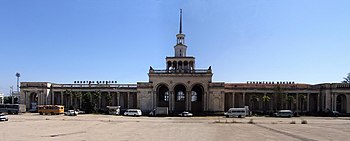Senaki – Adler railway line
| Senaki eagle | |||||||||||||||||||||||||||||||||||||||||||||||||||||||||||||||||||||||||||||||||||||||||||||||||||||||||||||||||||||||||||||||||||||||||||||||||||||||||||||||||||||||||||||||||||||||||||||||||||||||||||||||||||||||||||||||||||||||||||||||||||||||||||||||||||||||||||||||||||||||||||||||||||||||||||||||||||||||||||||||||||||||||||||||||
|---|---|---|---|---|---|---|---|---|---|---|---|---|---|---|---|---|---|---|---|---|---|---|---|---|---|---|---|---|---|---|---|---|---|---|---|---|---|---|---|---|---|---|---|---|---|---|---|---|---|---|---|---|---|---|---|---|---|---|---|---|---|---|---|---|---|---|---|---|---|---|---|---|---|---|---|---|---|---|---|---|---|---|---|---|---|---|---|---|---|---|---|---|---|---|---|---|---|---|---|---|---|---|---|---|---|---|---|---|---|---|---|---|---|---|---|---|---|---|---|---|---|---|---|---|---|---|---|---|---|---|---|---|---|---|---|---|---|---|---|---|---|---|---|---|---|---|---|---|---|---|---|---|---|---|---|---|---|---|---|---|---|---|---|---|---|---|---|---|---|---|---|---|---|---|---|---|---|---|---|---|---|---|---|---|---|---|---|---|---|---|---|---|---|---|---|---|---|---|---|---|---|---|---|---|---|---|---|---|---|---|---|---|---|---|---|---|---|---|---|---|---|---|---|---|---|---|---|---|---|---|---|---|---|---|---|---|---|---|---|---|---|---|---|---|---|---|---|---|---|---|---|---|---|---|---|---|---|---|---|---|---|---|---|---|---|---|---|---|---|---|---|---|---|---|---|---|---|---|---|---|---|---|---|---|---|---|---|---|---|---|---|---|---|---|---|---|---|---|---|---|---|---|---|---|---|---|---|---|---|---|---|---|---|---|---|---|---|---|---|---|---|---|---|---|---|---|---|---|---|---|---|---|---|---|---|---|---|
|
Sukhumi station
| |||||||||||||||||||||||||||||||||||||||||||||||||||||||||||||||||||||||||||||||||||||||||||||||||||||||||||||||||||||||||||||||||||||||||||||||||||||||||||||||||||||||||||||||||||||||||||||||||||||||||||||||||||||||||||||||||||||||||||||||||||||||||||||||||||||||||||||||||||||||||||||||||||||||||||||||||||||||||||||||||||||||||||||||||
| Route length: | 242 km | ||||||||||||||||||||||||||||||||||||||||||||||||||||||||||||||||||||||||||||||||||||||||||||||||||||||||||||||||||||||||||||||||||||||||||||||||||||||||||||||||||||||||||||||||||||||||||||||||||||||||||||||||||||||||||||||||||||||||||||||||||||||||||||||||||||||||||||||||||||||||||||||||||||||||||||||||||||||||||||||||||||||||||||||||
| Gauge : | 1520 mm / 1524 mm | ||||||||||||||||||||||||||||||||||||||||||||||||||||||||||||||||||||||||||||||||||||||||||||||||||||||||||||||||||||||||||||||||||||||||||||||||||||||||||||||||||||||||||||||||||||||||||||||||||||||||||||||||||||||||||||||||||||||||||||||||||||||||||||||||||||||||||||||||||||||||||||||||||||||||||||||||||||||||||||||||||||||||||||||||
| Power system : | 3 kV = | ||||||||||||||||||||||||||||||||||||||||||||||||||||||||||||||||||||||||||||||||||||||||||||||||||||||||||||||||||||||||||||||||||||||||||||||||||||||||||||||||||||||||||||||||||||||||||||||||||||||||||||||||||||||||||||||||||||||||||||||||||||||||||||||||||||||||||||||||||||||||||||||||||||||||||||||||||||||||||||||||||||||||||||||||
|
|||||||||||||||||||||||||||||||||||||||||||||||||||||||||||||||||||||||||||||||||||||||||||||||||||||||||||||||||||||||||||||||||||||||||||||||||||||||||||||||||||||||||||||||||||||||||||||||||||||||||||||||||||||||||||||||||||||||||||||||||||||||||||||||||||||||||||||||||||||||||||||||||||||||||||||||||||||||||||||||||||||||||||||||||
The Senaki – Adler railway runs on the east coast of the Black Sea and established a connection between Russia and Georgia until a section of the line was closed. Most of the route is in the Republic of Abkhazia, which is only recognized by a few countries .
history
Since the opening of the Poti – Baku railway on May 2, 1883, the Georgian part of the Russian Empire was connected to the Russian railway network via Baku (now Azerbaijan ) and Makhachkala . For the western part of Georgia, however, this route meant a considerable detour. The possibility of a shorter connection only became apparent after the opening of the Tuapse – Sochi line along the east coast of the Black Sea in 1923, which was extended to Adler in 1927 .
The connection of the route was planned in Senaki , 40 route kilometers east of Poti and 272 route kilometers west of Tbilisi . The first section to Gali was opened on September 15, 1930 by the state Transcaucasian Railway . The commissioning of the next section from Gali to Otschamtschire took place on May 20, 1938. In the same year, on October 1, 1938, Sukhumi , the capital of the Abkhaz Autonomous Soviet Socialist Republic within the Georgian Soviet Socialist Republic , was attached. Before the continued construction of the main line in 1940 two branches off to the east routes have been put into operation in May the 6-kilometer route to Zugdidi (1965 to Jvari extended), and in June, the 26 km long route to Tkvarcheli .
Closing the gap to Adler started from the north. The section eagle Bzyb River was opened in September 1943, the last section of Sukhumi-Bzyb River in May 1944. After 1932 the first Georgian routes were electrified and Senaki was in 1948 connected to the electrified rail network, was since 1954 the route Senaki- Adler electrified. The Senaki – Sukhumi section was completed in May 1954, the continuation of Sukhumi – Adler in April 1956.
The main line along the coast was not completed until 1945. At the time of the Soviet Union , it was one of only two railway connections between the southern Caucasus ( Georgian , Armenian and Azerbaijani SSR ) and the rest of the country and therefore of great importance. For today's severely restricted traffic between the Caucasus republics and Russia, only the Baku - Makhachkala route along the coast of the Caspian Sea is available. Until 1991, the route network of the Abkhaz Railway was part of the Transcaucasian Railway within the Soviet Railways and was administered from Tbilisi . With the collapse of the Soviet Union, the Transcaucasian Railway was essentially divided into the Georgian and Armenian Railways . In 1992, due to Abkhazia's declaration of independence, the Abkhazian rail network was effectively separated from the Georgian Railway. During the following fighting, u. a. the border bridge over the Inguri destroyed. Rail traffic between core Georgia and Abkhazia (and thus also Russia) has been interrupted since then. In the course of the conflict, the Georgian station names on the station buildings were removed, so that today mostly only the labels in Abkhazian and Russian are preserved. The destroyed routes within Abkhazia were quickly restored, not least for military reasons.
Today, however, the catenary is only in operation between Psou and Sukhumi . At the same time, this is the only section of the route in Abkhazia where passenger traffic takes place, which is currently limited to through coach connections from Sukhumi to Moscow . The through coaches are placed on the Adler-Moscow long-distance train in the Russian Adler . Until the end of 2007, suburban trains were still running on the Sochumi- Gudauta section . However, due to the poor condition of the rolling stock, operations had to be stopped. Since June 28, 2010, suburban trains (so-called " Elektritschkas ") have been running again from the Russian Eagle to Abkhazia. First the trains end in Gagra . However, the Russian operating company is interested in expanding operations into the Abkhaz capital. The competitiveness of railway operations, especially in local traffic, is endangered by the low speed due to the state of the superstructure. The trains can currently only run at a speed of 40 km / h and also have to stand still for over an hour at the Russian-Abkhazian border.
The connection to the Georgian heartland is interrupted. The last train station on the Abkhazian side is Achguara . The infrastructure and rolling stock of the Abkhazian Railway are now largely in poor condition and require major investments. But the rails, especially on the section from Gali to the Abkhaz-Georgian border, are no longer available. There the railway bridge was blown up again and again during the armed conflicts and has not been rebuilt to this day.
In May 2009, Abkhazia and Russia agreed to hand over the infrastructure of the Abkhaz Railways to Russian Railways for ten years .
Picture gallery
Psyrzcha stop (2008)
See also
Notes on the gauge: gauge (railway), measurement method of the Russian gauge or Russian broad gauge .
Web links
- Private page about the Abkhaz Railway (Russian)
- History of the Abkhaz Railway (Russian)
- Private Page with Photos of Abkhaz Railway Stations (Russian)
Individual evidence
- ↑ abkhaziagov.org: Возобновилось движение электропоездов из России в Абхазию ( Memento of the original from September 21, 2011 in the Internet Archive ) Info: The archive link was automatically inserted and not yet checked. Please check the original and archive link according to the instructions and then remove this notice. (June 28, 2010)
- ↑ Russia News : Russia is taking over Abkhazia's transport infrastructure







